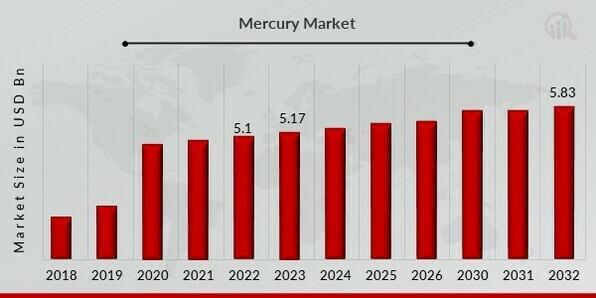Mercury, the smallest and innermost planet in our solar system, may seem like an unlikely subject for market discussion. However, the element mercury, also known as quicksilver, holds significant economic importance in various industries despite its toxic nature. From electronics to healthcare, the Mercury Market presents a complex landscape influenced by regulatory measures, technological advancements, and shifting global demand.

Mercury Market size was estimated at $5.1 Billion in 2022 and is expected to reach $5.831 Billion by 2032, growing at a CAGR of 1.50% during the forecast period of 2023 to 2032.
Historical Significance and Current Dynamics
Mercury has a long history of use, dating back to ancient civilizations where it was employed in medicine, religious rituals, and even as an elixir of life. However, its modern applications are far more diverse. One of the primary uses of mercury is in the production of chlorine and caustic soda, where it serves as a catalyst in the chlor-alkali industry. Additionally, it finds applications in electrical switches and relays, fluorescent lamps, and thermometers.
Despite its utility, the mercury market trends faces challenges due to environmental concerns. Mercury is a potent neurotoxin that can accumulate in living organisms, posing significant risks to human health and the environment. Consequently, stringent regulations aimed at reducing mercury emissions have been implemented globally, impacting its production and usage.
Global Demand and Supply Dynamics
The demand for mercury varies across different sectors and regions. While developed countries have largely phased out mercury-containing products, developing economies still rely on it for various industrial processes. For instance, artisanal and small-scale gold mining (ASGM) remains a significant source of mercury demand in regions like Africa, Asia, and South America.
On the supply side, mercury is primarily obtained as a byproduct of other metal extraction processes, such as gold and silver mining. Spain, Kyrgyzstan, and China are among the leading mercury producers globally. However, the mercury companies is relatively small compared to other metals, with annual production and consumption measured in tons rather than millions of tons.
Emerging Trends and Future Outlook
Advancements in technology are driving changes in the mercury market. For instance, there is a growing interest in developing mercury-free alternatives for various applications. In the chlor-alkali industry, membrane cell technology is gradually replacing mercury-cell technology, reducing the reliance on mercury catalysts. Similarly, the transition towards energy-efficient lighting solutions has led to the phasing out of mercury-containing fluorescent lamps in favor of LEDs.
Furthermore, the increasing focus on sustainability and corporate social responsibility is influencing consumer preferences and supply chain practices. Companies are under pressure to adopt environmentally friendly practices and reduce their mercury footprint, leading to innovations in product design and manufacturing processes.
Challenges and Opportunities
Despite the progress made in reducing mercury use and emissions, challenges persist. Illegal and unregulated artisanal gold mining continues to be a significant source of mercury pollution in many parts of the world, necessitating coordinated efforts from governments, industry stakeholders, and environmental organizations to address this issue.
Nevertheless, the mercury market size also presents opportunities for innovation and investment. Research into alternative materials and technologies holds the potential to create safer and more sustainable solutions across various industries. Additionally, initiatives aimed at recycling and proper disposal of mercury-containing products can help minimize environmental impacts and conserve valuable resources.
In conclusion, the mercury market is characterized by a complex interplay of technological, regulatory, and environmental factors. While challenges such as pollution and regulatory compliance persist, there are also opportunities for innovation and sustainable development. By leveraging advancements in technology and adopting responsible practices, stakeholders can navigate the mercury market towards a safer and more sustainable future.
About Market Research Future:
Market Research Future (MRFR) is a global market research company that takes pride in its services, offering a complete and accurate analysis of diverse markets and consumers worldwide. Market Research Future has the distinguished objective of providing optimal quality research and granular research to clients. Our market research studies by products, services, technologies, applications, end users, and market players for global, regional, and country level market segments, enable our clients to see more, know more, and do more, which help answer your most important questions.
Contact:
Market Research Future (Part of Wantstats Research and Media Private Limited)
99 Hudson Street, 5Th Floor
New York, NY 10013
United States of America
+1 628 258 0071 (US)
+44 2035 002 764 (UK)
Email: sales@marketresearchfuture.com
Website: https://www.marketresearchfuture.com

